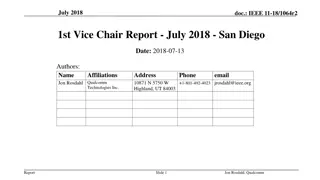
Serum Triglyceride Testing and Risk Factors
Learn about serum triglyceride testing, its importance in assessing heart disease risk, when to get tested, sample requirements, test preparation, and the association with cardiovascular disease. Understand the normal range and implications of high triglyceride levels.
Download Presentation

Please find below an Image/Link to download the presentation.
The content on the website is provided AS IS for your information and personal use only. It may not be sold, licensed, or shared on other websites without obtaining consent from the author. If you encounter any issues during the download, it is possible that the publisher has removed the file from their server.
You are allowed to download the files provided on this website for personal or commercial use, subject to the condition that they are used lawfully. All files are the property of their respective owners.
The content on the website is provided AS IS for your information and personal use only. It may not be sold, licensed, or shared on other websites without obtaining consent from the author.
E N D
Presentation Transcript
Serum Triglyceride MuthanaAl-Shemeri Lab. Assistants, Mrs Ferdws Ghazi Mr Jamal Abdulfattah
Structure Triglyceride sources
Why Get Tested? To assess your risk of developing heart disease; to monitor effectiveness of lipid-lowering therapy. When to Get Tested? Screening: as part of a lipid profile during a regular medical exam at least once every four to six years for adults; for children, at least once between the ages of 9 and 11 and again between the ages of 17 and 21. Monitoring: may be done more frequently if you have risk factors for heart disease and/or if you are being treated for unhealthy lipid levels.
Sample Required? A blood sample drawn from a vein in your arm or from a finger stick. Test Preparation Needed? Fasting for 9 to 12 hours before the test, only water is permitted. In addition, alcohol should not be consumed for 24 hours just before the test.
What is being tested? Some triglycerides circulate in the blood to provide fuel for muscles to work. After a person eats, an increased level of triglycerides is found in the blood as the body converts the energy not needed right away into fat. Triglycerides move via the blood from the gut to adipose tissue for storage. In between meals, triglycerides are released from fat tissue to be used as an energy source for the body. Most triglycerides are carried in the blood by lipoproteins called (VLDL).
Association with CVD High levels of triglycerides in the blood are associated with an increased risk of developing cardiovascular disease (CVD), although the reason for this is not well understood. Certain factors can contribute to high triglyceride levels and to risk of CVD, including: lack of exercise, being overweight, smoking cigarettes, consuming excess alcohol, Having medical conditions such as diabetes and kidney disease.
Normal range is less than 150 mg/dl Borderline high (150 199 mg/dl) High (200 499) mg/dl. Very high 500 mg/dl or higher






















